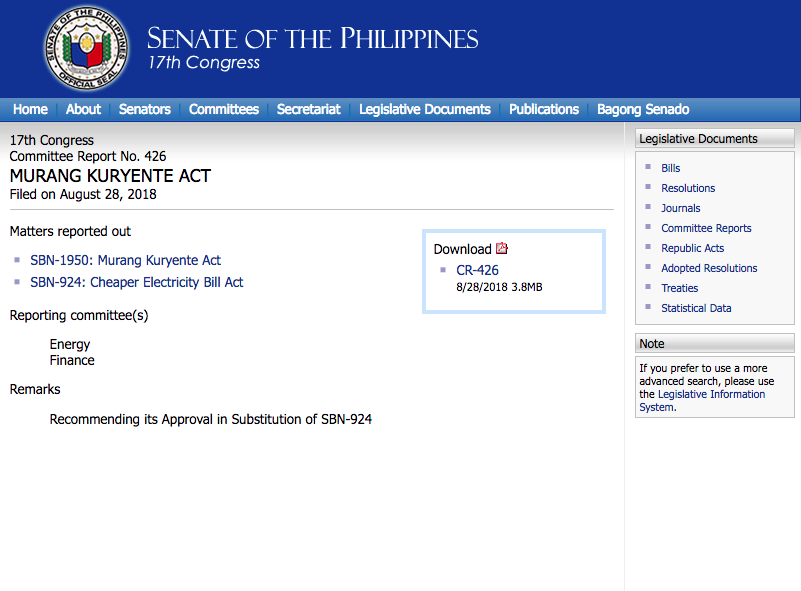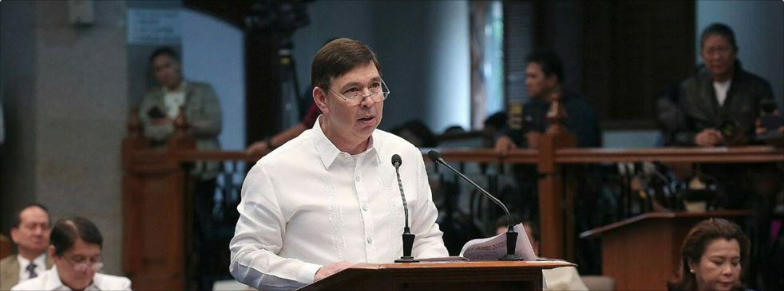Sponsorship Speech on Murang Kuryente Act
I am pleased to join Senator Win in sponsoring this bill, which provides a “win-win” solution to a looming power rate increase that will further burden consumers who are already reeling from inflationary shocks.
One good thing about the hardworking gentleman that I’ve noticed is that he never runs out of light bulb moments, and this bill is once again proof of his policy industriousness.
And I am sure that when this bill is passed into law, he won’t mind the PCOO misquoting him for as long as they spell his name right.
Mr. President:
In a nutshell, this bill allows the use of government’s net Malampaya income in paying for the stranded contract costs and debts assumed by PSALM, as mandated by EPIRA.
To recall, when the state’s power assets were privatized, all liabilities were transferred to one holding entity – the PSALM.
The idea was to clean the books of assets for disposal, so that when unburdened of obligations, it would be easier to auction off.
On paper, the stranded costs and debts left behind would be covered by proceeds of power plants and other assets sold. But the fine print states that any difference will be shouldered by the consumers.
This explains why our electricity bill contains that seemingly innocuous item called Universal Charges (UC). It is where these stranded costs are lumped together with other unitemized payables.
UC amortizes past mistakes. Because like any business, power democratizes debt, but privatizes profit.
The projection is that these orphaned debts— mga naiwang utang— assumed by PSALM, will hit P566.2 billion by 2026, when PSALM’s corporate life will end.
By the end of 2031, the financial obligation shall be P595.6 billion—the increased amount due to repayments sourced from borrowings. This proves true the adage that debts left by one generation to be paid by another has a life of radioactive waste.
We can settle this obligation the old way: by passing it on to consumers. This will add 87 centavos per kilowatt hour consumed.
Or the painless way: by using the Malampaya fund to wipe the slate clean – and the frown on the face of the housewife who will pay a higher bill if the settlement is by way of a Universal Charge.
If the Malampaya fund will be tapped to pay for the stranded costs and debts lodged with PSALM, then we must first ascertain what its status is.
Has it disappeared, dissipated, or been diluted? Has the katas ng gas vanished into thin air?
Hindi po. The Treasury says the fund’s outstanding balance as of end 2017 is P204 billion. Thus, the 60 percent national government share is about P123 billion.
Whatever the amount of the NG share is, it does not include the 40 percent share of the local governments nearest the Malampaya gas field, which is embroiled in legal dispute.
I have to stress that this bill only deals with the NG share. The LGU share, specifically of Palawan, remains off limits. My personal stand is, “Ibigay kay Juan ang kay Juan. At ibigay kay Jose, ang kay Jose. Kung kay Jose Alvarez yan, sundin ang batas at igalang ang hukuman.”
The rule in earmarking is: Thou shalt not give away what is not yours. After all, this gas-to-treasury windfall is so big that it can finance many projects as mandated by law.
Off northern Palawan, the Malampaya is a deep water gas-to-power project. Piped in to Batangas, the gas fuels five natural gas plants in the province.
The combined 3,211 megawatt output of the plants meet almost half of the energy needs of the 57 million people living in Luzon, the world’s 4th most populous island.
A related issue, which I must interject here because of its importance, is that Malampaya, which provides 50 percent of the energy consumption of the Senate, and of our homes, will sharply taper off its production by 2024.
That is six years from now.
While energy officials and the gas field’s driller have assured us that a combination of measures will stretch Malampaya’s life to 2029, what is clear is that it will be downhill beginning 2024.
This makes the hunt for indigenous oil supply that will replace Malampaya’s void urgent. Luzon is facing a dark future if we cannot find a replacement for Malampaya. 2024 could be the zero dark moment.
But in the meantime, we should use Malampaya to ease the burden of households.
This bill, I have been assured, complies with Presidential Decree 910, and the Supreme Court ruling on the matter. The katas ng Malampaya will be plowed back to an activity which is related to energy.
Mr. President:
I call for the immediate passage of this bill.
_________________________________________________________________________________________________________

• Committee Report No. 426
• Senate Bill No. 1950: Murang Kuryente Act
RELATED ARTICLES:
-
12 NOV 2016: Scientists not bureaucrats must greenlight BNPP rehab – Recto
-
18 JUL 2016: Recto: Solar power in gov’t offices to free P1.2 billion a year for social services
-
24 NOV 2015: Tap P170B Malampaya fund for saltwater lamp production
-
19 SEP 2014: Tap unspent P180B Malampaya energy royalties for emergency power needs
-
25 SEP 2013: Recto: Use Malampaya fund for power rates reduction, AFP Modernization
SENATE BILLS:
-
21 JUL 2016: Cheaper Electricity Bill Act
-
04 JUL 2016: Senate Bill No. 268: The Solar Energy in National Government Offices Act of 2016


